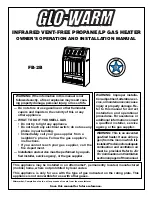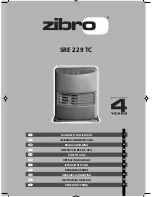
11
www.UsePhoenix.com • [email protected]
Toll-Free 1-800-533-7533
a. Remove the chimney rain cap.
b. With the burner firing, cover the chimney flue pipe
so it is blocked off completely. This should cause the
pressure switch contacts to open and shut down the
burner.
c. Remove the cover from the pipe and replace the
rain cap. The burner should not try to re-light since the
switch must be manually re-set.
d. By pushing the reset button (located under the
electrical box cover of the pressure switch), the control
will reset and the burner should light again.
e. This control should be tested every time, when
putting the system into operation on a new project or a
minimum of once yearly.
G. Procedure for cleaning flue gas passageways. This
procedure should be performed in the event of blockage in
the flue gas passage due to soot or any other obstruction
that may occur. Improper burner settings or maintenance
could cause soot accumulation in the combustion
chamber. The following steps should be taken to clean out
the chamber flue gas passageway. Must be performed by a
trained service technician ONLY.
a. Shut off and disconnect external electrical power
supply.
b. Drain the heat transfer fluid from the system.
c. Exterior cabinet side panels and the cabinet
door & framing members, at the burner end of the
cabinet, should be removed, to facilitate access to
the combustion chamber. The control panel should
be loosened from its mounting frame. These are all
bolt-on components.
d. Once access to the chamber has been gained,
disconnect the burner electrical supply line and
fuel supply line and remove the burner. Two bolts
will need to be removed that hold the burner to its
mounting flange.
e. Disconnect the flue gas vent pipe by removing
screws. Remove the pipe and rain cap assembly and
clean its interior thoroughly.
f. The two hoses are connected to 1” fittings that
protrude through the front flange plate disk of the
combustion chamber. These hoses will need to be
disconnected by loosening the hose clamps and
pulling the hose off the insert barbs.
g. Remove 8 bolts that hold the chamber flange plate
disk to the main chamber body.
h. The inner section of the combustion chamber can
now be pulled straight out of the main chamber body.
All flue gas contact surfaces are now exposed and
can be easily cleaned with vacuum cleaner, brushes
or other cleaning utensils.
i. To re-assemble the unit, replace components in
reverse order to which they were removed.
j. Reconnect fuel and power supply to the unit and
when re-starting the system perform all safety and
service checks as outlined above.
H. The FireBird HD308 will produce condensate while
operating, at any time that the circulating fluid is cooler
than approximately 130ºF (54ºC). A clear poly-tube is
connected to a fitting in the bottom of the chamber at
front and is routed to the outside of the cabinet to carry
condensate away. This tube should be inspected and
cleaned, if necessary, when putting the system into
operation on every new project or a minimum of once
yearly.
I. On a daily basis, the area around this system must
continue to be kept clear and free from combustible
materials, gasoline and all other flammable vapors and
liquids.
J. At the circulation pump end of the FireBird HD308
cabinet, louvers are stamped into the access door to
provide intake air for combustion and ventilation. Check on
a daily basis to ensure that nothing is allowed to obstruct
this free-flow of air.
K. Check heat transfer fluid level daily. Maintain between
¼ and ¾ level during normal operation. If excessive fluid
loss occurs check all hoses and connections for leaks.
Top-up only with approved HTF. (see section 4.3 for
details).
L. Verify that all gauges are maintaining within their
desired operating ranges with respect to setpoint.
M. Check fuel tank level daily and order fuel as required.
N. Make sure that all access doors and panels are kept
closed and locked while the system is in use.
O. If fluid-flow should become reduced, as indicated by
the flow light going out and burner not starting, isolate and
clean the Y-strainer. To clean the Y-strainer (Fig. 33): The
ball valve immediately to the left of the Y-strainer must
be closed and the quick-coupler connection immediately
to the right (on the outside of the cabinet) must be
disconnected. This will isolate the Y-strainer. The cap on
the Y-branch can now be removed so the cylindrical screen
can also be removed. Clean the screen with compressed
air or a small wire brush. Put the screen back in place and
re-engage the cap, quick coupler connection and valve.
For further service assistance
Call the manufacturer toll free at: 1-800-533-7533
OR
Call to speak to an hydronic service specialist direct
at: 1-306-921-5227




































